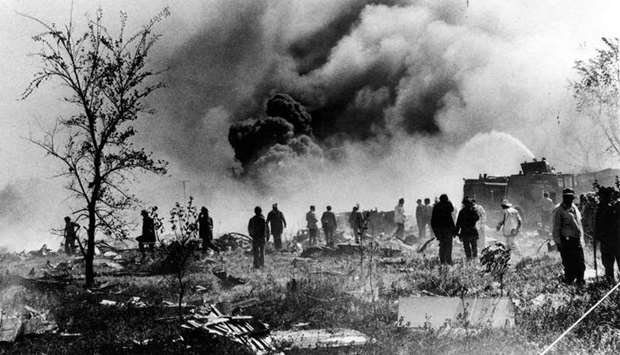As the three-engine McDonnell Douglas DC-10 accelerated down the runway, reaching takeoff speed, the left engine broke away, vaulting over the aircraft’s wing. After just 31 seconds of flight, it plunged back to earth, killing all passengers and crew members, writes Lauren Zumbach.
As 258 passengers filed on to American Airlines Flight 191 at O’Hare International Airport the Friday before Memorial Day in 1979, nothing suggested that they would never reach Los Angeles.
They would have listened to the flight attendant instruct them how to buckle the seat belt and where to find the emergency exits.
None of that would matter.
As the three-engine McDonnell Douglas DC-10 accelerated down the runway, reaching takeoff speed, the left engine broke away, vaulting over the aircraft’s wing. The pilots heard a thunk.
“Damn,” one of the pilots said.
It would be the last word captured by the cockpit voice recorder.
The plane continued to rise, its wings level, despite the nearly 13,500 pounds suddenly missing from its left side. But as it reached 300 feet, the plane slowed and rolled left until it began to overturn, its nose tipping down.
After just 31 seconds of flight, the plane plunged back to earth, killing all the passengers and 13 crew members on board.
The wreckage strafed an open field and mobile home park, scattering debris and erupting into flames. Bodies were burned beyond recognition.
Forty years later, the crash of Flight 191 remains the deadliest passenger airline accident on US soil.
Its legacy helped spur reforms that contributed to a vast improvement in commercial aviation safety.
“It had a lasting impact on how aircraft maintenance is overseen,” said former Federal Aviation Administration chief of staff Michael Goldfarb. “It was just a stark reminder those things are very important.”
The changes didn’t happen overnight. A series of air disasters in the decade and a half that followed, coupled with rising demand for air travel that put more passengers on more airplanes each day, forced the industry to reckon with its safety record, aviation safety experts said.
It worked. With improvements in technology, training and systems meant to flag problems before they lead to accidents, it’s been more than a decade since the last fatal crash on a scheduled passenger flight by a US airline.
But two months ago, weeks after that 10-year milestone was achieved, the industry faced another crisis. The second fatal crash of a Boeing 737 Max overseas within less than six months led to a global grounding of the plane — one of the only times regulators grounded an entire fleet since Flight 191 crashed in Chicago. As investigations into those two accidents continue, regulators and industry officials worldwide are conducting a reassessment of safety procedures.
To some, the crashes of the 737 Max served as a necessary caution against complacency.
Ralph Nader, the consumer advocate whose niece died in the March 10 Max crash in Ethiopia, likened the industry’s approach to safety to a rubber band that has been repeatedly stretched without breaking.
“You get complacent about how much you can stretch it, and it snaps,” he said.
The crash
Dan Cirignani, a police officer patrolling the airport roads on foot that afternoon, didn’t see the plane go down. But it was impossible to miss the black smoke clouding the sky over the airport. He wondered if it was a drill.
But a voice on his radio called all personnel to a “strike on the field” — a plane crash. Then he heard the sirens.
Firefighters from Elk Grove Village, which borders O’Hare, were on the scene in four minutes. They’d been told a plane had crashed. But the smoke was so thick that Bill Clark, a lieutenant at the time, said he couldn’t be certain until he sliced through a fence and saw the deep furrow the aircraft made in the ground, along with debris and victims.
It was obvious that no-one on board could have survived, he said.
“It was total devastation. There was nothing we could do to change what happened,” said Clark, now Schaumburg’s emergency management co-ordinator.
In addition to the passengers and crew, two people on the ground were killed and two more suffered second- and third-degree burns when hit by burning jet fuel, Clark said. An old aircraft hangar, several cars and a mobile home were also destroyed.
Cirignani, 76, who retired in 2005 and now lives in Barrington, had worked fires and crashes before. But the first time he saw one of the victims, he didn’t immediately recognise it as a body.
“I had to ask the pathologist,” he said. “They looked like black coal.”
For a while, he refused to light a grill, and remains cautious when it comes to anything to do with fire.
“The carnage, it was just one of the most horrible things you’ve ever seen,” he said.
The intensity of the blaze and sheer number of people on board made identifying the victims unusually difficult, said Edward Pavlik, an orthodontist and chief of forensic sciences for the Cook County sheriff’s office, who was part of a team of forensic dentists that worked to identify victims of Flight 191.
High-pressure hoses used to extinguish the blaze left a crater in the ground filled with “a tangled mess,” said Pavlik, 76, of Homer Glen.
Several of the victims had been headed to the American Booksellers Association convention in Los Angeles, including local author Judith Wax and her husband, Playboy Magazine Managing Editor Sheldon Wax. Other travellers came from as far away as Australia, Austria, Belgium and the Netherlands.
The wreckage was too badly damaged to give investigators much useful information, except for the engine that broke away from the wing.
It would provide important answers to both questions facing investigators: Why had the engine and structure attaching it to the wing broken off? And why had pilots lost control of a plane that, though badly damaged, was designed to fly even if an engine failed?
The investigation
Within days of the crash, the Federal Aviation Administration ordered other carriers to inspect their DC-10s, focusing on the area where the engine attaches to the wing.
Ernie Gigliotti was one of the night shift mechanics United Airlines tapped at O’Hare. As he did the inspection, “I just had the feeling there was something not right,” said Gigliotti, 71, who retired in 2002 and lives in Pittsburgh. He pushed on the engine nose and felt it move side to side rather than up and down, and heard an unusual metallic noise. He and his partner removed more panels and found obvious damage: fractures, and bolts with the heads sheared off.
When American and Continental Airlines also found damage to their DC-10s during the ordered inspections, the FAA grounded the DC-10 fleet on June 6, 12 days after the crash.
The National Transportation Safety Board traced Flight 191’s damage to American’s decision to ignore McDonnell Douglas’ instructions during a maintenance procedure that required removing the engine and the pylon connecting it to the wing.
The DC-10’s manual instructed workers to take off the heavier engine before detaching the pylon. But removing the engine and pylon as a unit saved about 200 man-hours per aircraft, according to the NTSB.
“That equals money,” said Anthony Brickhouse, associate professor of aerospace and occupational safety at Embry-Riddle Aeronautical University. “And that’s the battle you constantly fight in safety, it’s safety versus money.”
American also decided to use a forklift, which wasn’t precise enough to remove and reattach the engine without risking damage, the NTSB said.
But if damage during a maintenance check at American’s facility in Tulsa, Oklahoma, two months earlier explained why the engine came off, it didn’t fully explain why pilots lost control.
According to the NTSB, hydraulic lines that powered other critical systems were severed when the engine and pylon broke away, leaving the aircraft unusually vulnerable to a stall and disabling warning systems.
The NTSB said it wasn’t reasonable to expect Flight 191’s captain, Walter Lux, and first officer, James Dillard, to have recognised what was wrong with the aircraft in time to prevent a crash.
The aftermath
The fallout from the accident was, if nothing else, a call to action for an industry and its regulators.
The FAA slapped American and Continental with fines of $500,000 and $100,000, respectively, for improper maintenance.
Airlines were ordered to inspect their DC-10s for damage and stick to the Douglas-endorsed maintenance procedure. The FAA ordered improvements to the DC-10’s warning systems and revised flight manual procedures for handling an engine failure.
In addition, an Illinois law now encourages that dentures be marked with information identifying the wearer. Pavlik, the forensic dentist, said he pushed the measure after realising it could have helped verify victims’ identities.
The NTSB also called for broader changes, such as better tracking and reporting of maintenance-related damage, stricter oversight of maintenance and tougher vetting when airlines sought to deviate from manufacturer-endorsed methods.
Both airlines and regulators missed opportunities to spot the risks before the Flight 191 crash, either by better vetting the hazards of using the forklift or spotting red flags, the NTSB said in the report. Continental, for example, twice caught and repaired damage similar to that found on Flight 191 before the crash, but American told the safety board that it wasn’t aware other airlines had experienced problems.
The FAA declined to act on some of those recommendations at the time, arguing that existing regulations already went far enough or that the changes wouldn’t improve safety enough to justify the extra cost. — Chicago Tribune/TNS

AFTERMATH: Beneath the smoke lie fragments of the American Airlines Flight 191 jetliner that crashed and exploded on May 25, 1979, shortly after taking off from O’Hare International Airport.


